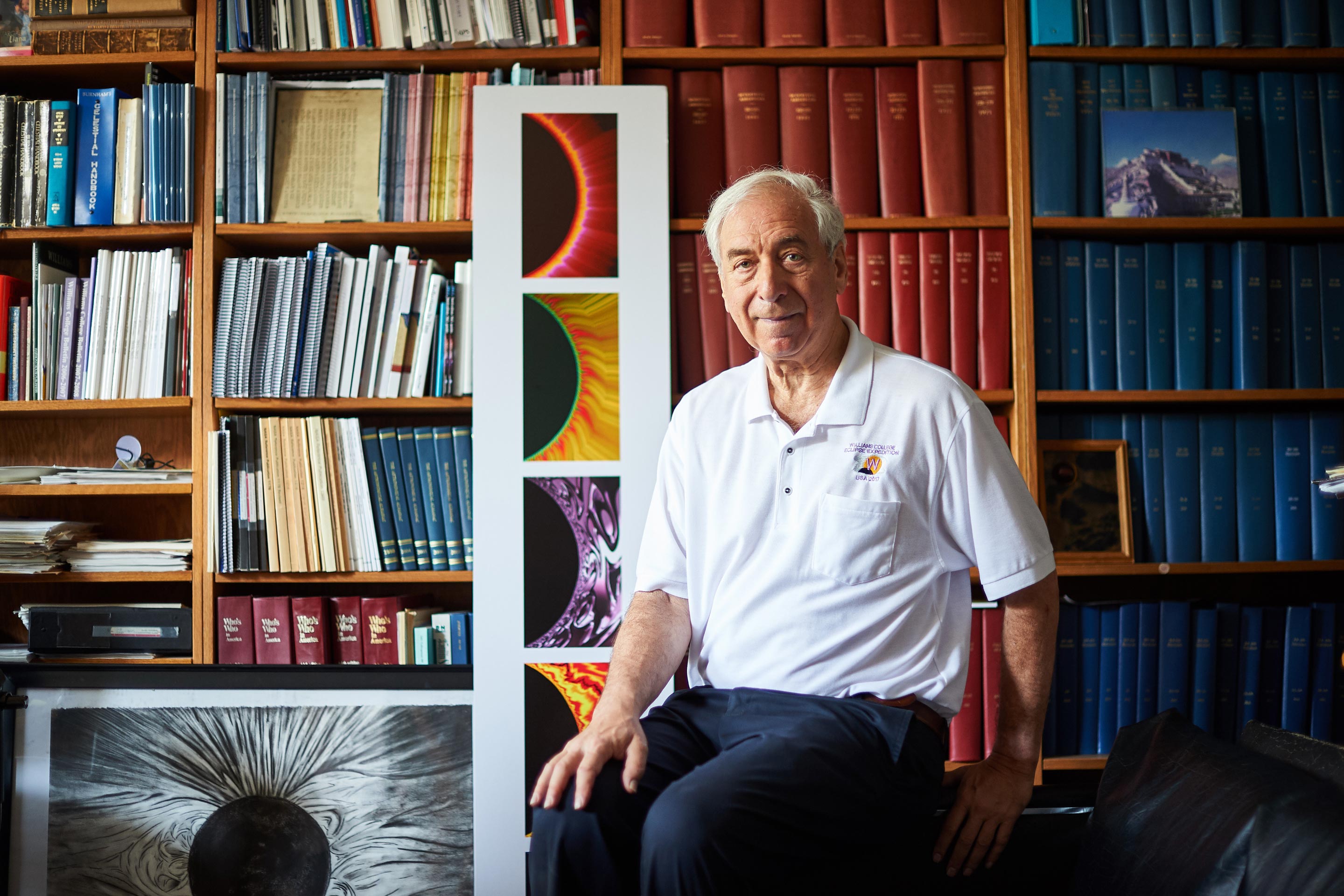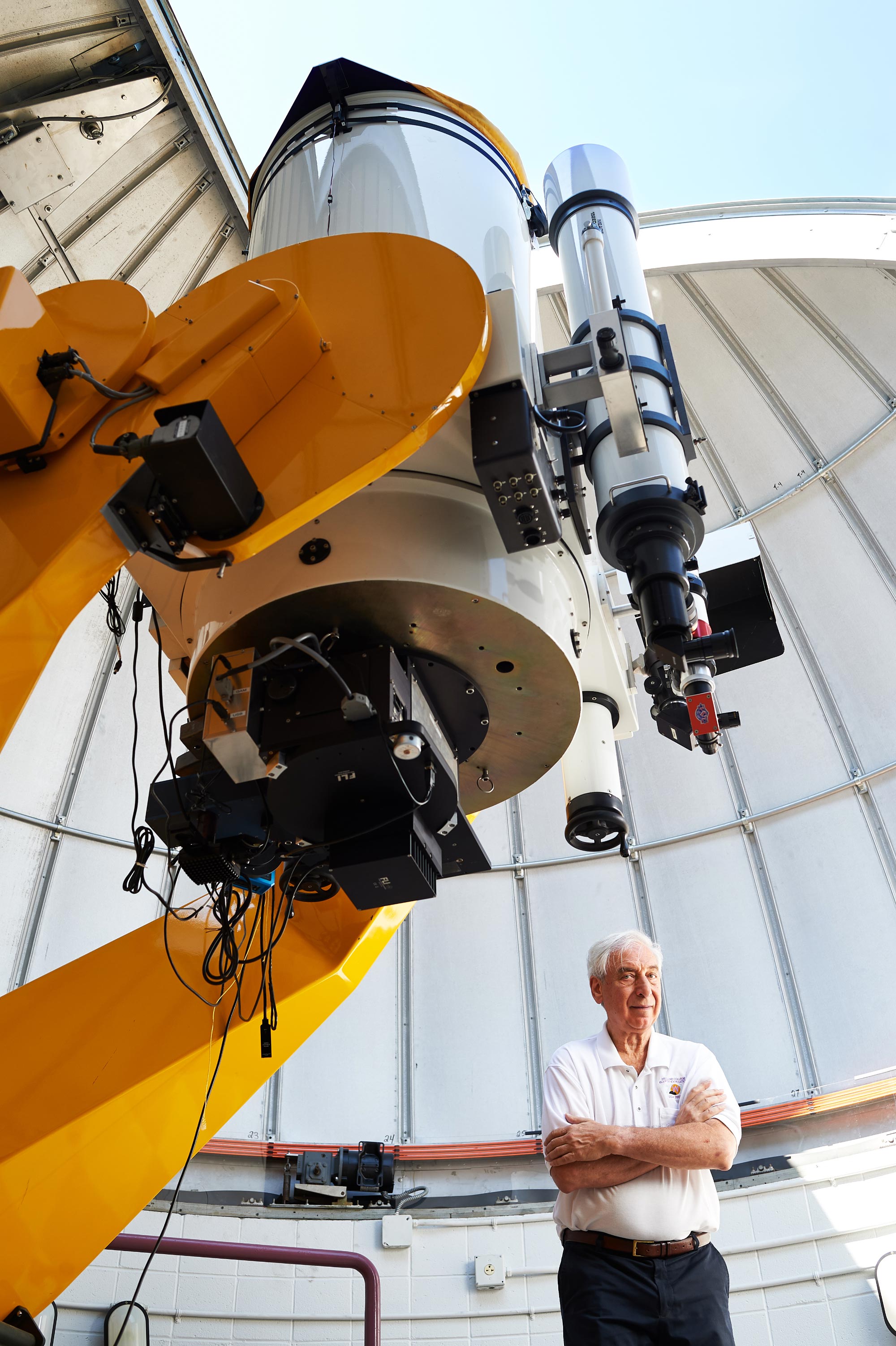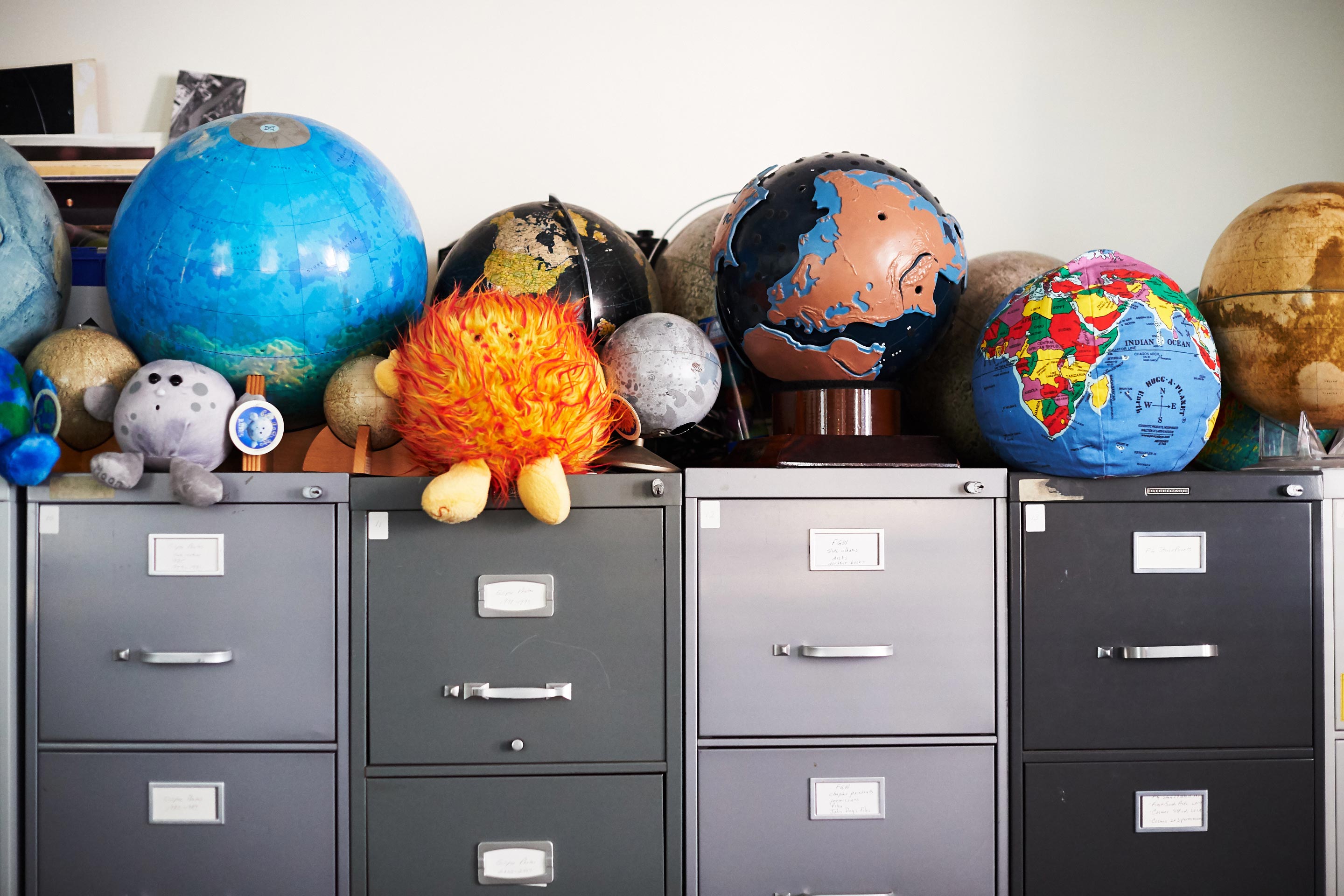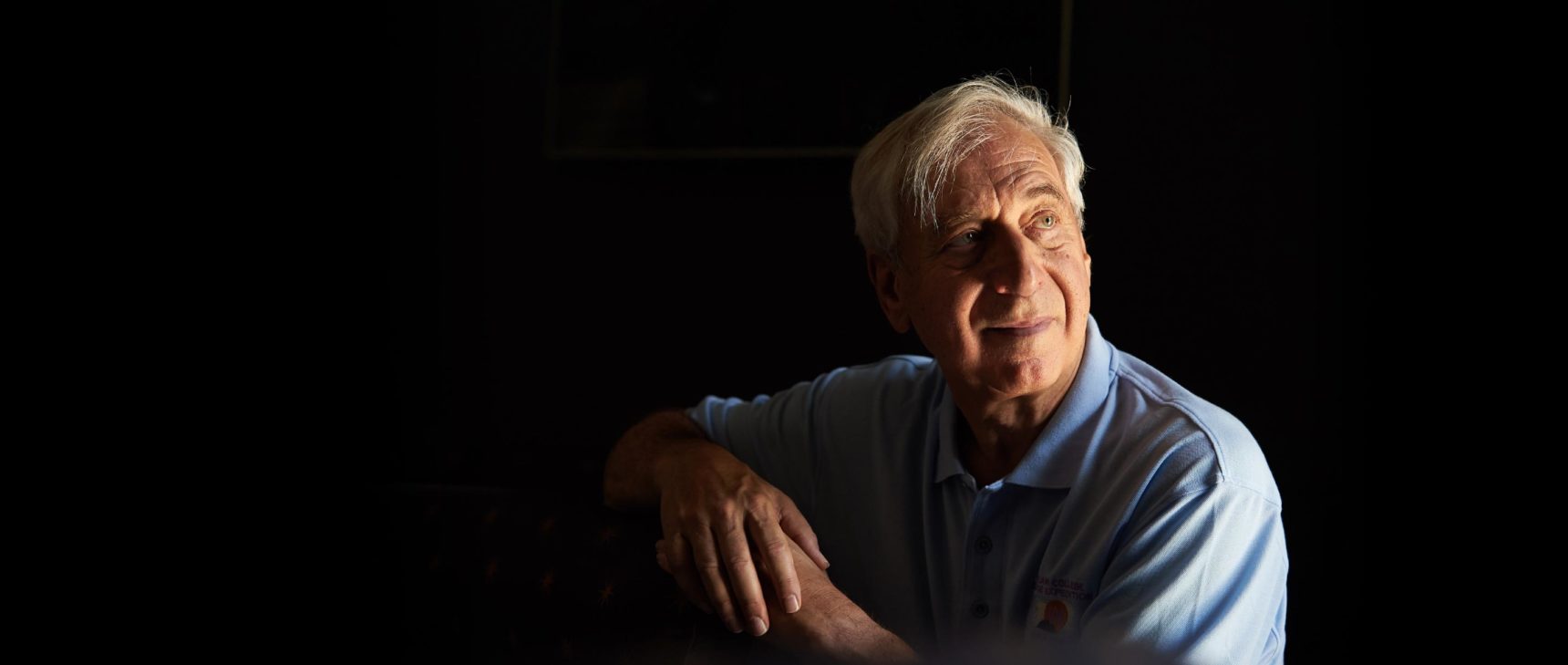Eclipse Hunter Reveals the Science That Can Only Be Done in the Dark

Jay Pasachoff in his office at Williams College.
Jennifer May for Quanta Magazine
Introduction
On Aug. 21, a total solar eclipse will be visible from a narrow ribbon of land — the “path of totality,” which stretches across the United States from Oregon to South Carolina. It will be the first total eclipse visible from the 48 contiguous states since 1979. These events are often described as once-in-a-lifetime experiences, but for Jay Pasachoff, they’ve come more often than that. He’s seen 33 total solar eclipses, and another 32 if you count partial eclipses and annular eclipses, in which the sun briefly looks like a ring or doughnut.
Pasachoff, an astronomer at Williams College in Massachusetts, will view the event in Salem, Oregon, accompanied by a group of students and thousands of pounds of equipment. That’s because even in this age of space probes and orbiting telescopes, there’s still a good deal of science that can be done from the ground during those brief moments in the moon’s shadow — science that, in fact, can be done only during a total solar eclipse.
Quanta spoke with Pasachoff about life as an eclipse chaser and the observation opportunities that only a total eclipse can bring. An edited and condensed version of the conversation follows.
Why do eclipses still matter when scientists have space-based observatories monitoring the sun at all times?
We professional astronomers take advantage of whatever special opportunities we have, to learn more about the sun and our universe. During an eclipse, we see parts of the sun that aren’t visible from Earth at other times and that are never visible from spacecraft. It’s only during an eclipse that we get a complete view of the sun, from the surface out through the corona — the sun’s tenuous outer atmosphere, which becomes visible during totality — and farther out, into what we call the heliosphere, the region of space dominated by the sun. So given that we only get a few minutes every 18 months or so, we astronomers certainly want to take advantage of this wonderful opportunity.

Pasachoff at the 24-inch telescope at Williams College’s Hopkins Observatory.
Jennifer May for Quanta Magazine
Today we have more than one space-based telescope equipped with a coronagraph, a kind of shield that blocks out the light from the photosphere, the bright disk of the sun. Don’t they accomplish the same thing as an eclipse?
It depends how much money you have. If you give me $10 billion, then I might be able to simulate an eclipse, using a space-based coronagraph. That’s as good as the ones that we get on Earth. But that hasn’t happened. The best coronagraph that we have in space is now over 20 years old, on the Solar and Heliospheric Observatory [SOHO]. It has three nested coronagraphs. The inner one is now defunct; in fact, it never worked very well. The two that remain, known as C2 and C3, are what we call externally occulted coronagraphs, which means there’s a disk that blocks some of the sun’s light, but the disk is located close to the lens and is therefore at a different focus than the corona. So to make it all work, it has to block three-quarters of a solar radius around the sun. And that’s the region that we see best, during an eclipse. And the C3 has an even bigger blockage.
So there’s a whole region, from the surface of the sun out to three-quarters of a solar radius that we can see in white light only during an eclipse. Further, the C2 coronagraph has a resolution of only 23 arc-seconds, whereas during an eclipse, from the ground, we can achieve two or maybe one and a half arc-seconds. So there’s an overlap region that we see during an eclipse — overlapping with what we see using the C2 coronagraph — and we’re seeing everything over 10 times more clearly, from the ground, during an eclipse. So if we want to study the region where the solar wind is formed and where we have these wonderful magnetic field displays and these solar coronal streamers, near the sun’s equator, and the plumes from the sun’s polar regions — then we need the eclipse, which we only get every 18 months or so, somewhere on Earth.
What kind of data, in particular, do you want to collect? Are we talking about images, or spectra, or something else?
Yes, yes, and yes: Images, and spectra, and something else! I feel a big responsibility, now that we have this eclipse in our home territory, to make the most complete observations possible. We have the advantage of the shipping being less expensive, compared to taking 2,000 pounds of equipment to India, which I have done, for an eclipse. So I’ve gathered, with the support of the U.S. National Science Foundation and the Committee for Research and Exploration of the National Geographic Society, a crack team of astronomers and equipment, to study the sun with a variety of telescopes and spectrographs.
What do you want to learn?
Perhaps the most difficult and most complex experiment in our group of a dozen or so experimental setups is to try to determine observationally which of the competing models of coronal heating is correct — to understand how the corona is heated to a million degrees. We know that it’s related to the sun’s magnetic field, but the details of just how it’s related are still unclear and are much debated among the theoreticians.
What are some of the ideas?
There’s a whole set of competing theories that involves something called nanoflares — where nano of course means a billionth — and so, instead of a few big solar flares erupting from the sun, there could just be a lot of little flares, each a billionth of the intensity of the big flare, going off all the time, thousands of them going off all the time. So that could account for much of the heating of the corona. Another idea involves coronal loops, oscillating loops of ionized gas held in place by the sun’s magnetic field. So we want to see what we can measure and see if we can distinguish between the contributions of nanoflare heating and coronal-loop wave heating.
How can you distinguish between the two?
Different models predict different kinds of oscillations and vibrations in the loops of gas held in place by the coronal magnetic field, in the lower corona. Some theories say that there should be vibrations with periods of many seconds; one set of theories predicts sub-second vibrations — and if the nanoflare idea is correct, there may be no oscillations at all.
We have some very special filters, in what’s called the coronal green line and the coronal red line — emission lines associated with electrons in highly ionized iron atoms in the solar corona, as they jump between energy levels at temperatures of a million or over a million degrees, respectively. The special filters isolate the hot coronal gas from the background coronal light that we see with our eyes, which is largely the everyday surface of the sun — the solar photosphere — scattered by the electrons in the corona. But with these special filters, we can pick out the actual emission from the corona. And we’re looking for very rapid vibrations.
Does that mean you need video or some way of capturing images at a very high frame rate?
What we use is even better than video, in that each observation is more precise. We use a special kind of CCD — an electronic charge-coupled device — that’s actually two CCDs in one. One is off to the side [of the camera], hidden behind a metal cover. We record images at a rate that can go up to 10 hertz — 10 times per second, or even more — and almost instantaneously the data is transferred to the CCD that’s hidden behind the metal shield, which can then be read out while the next image is being taken using the open one. The result of that is that there’s almost no dead time — we can take very high-precision observations without any gaps between the successive images.
We’ve been using this method very successfully for the last dozen years, on a series of occultations of stars by Pluto and other objects. We’ve had it at a transit of Venus, and we’ve had it at a previous eclipse, and we’re looking forward to using it at this eclipse.
I understand that eclipse measurements can also be used to track Earth’s rotation rate?
That’s right. Earth doesn’t rotate at a completely constant rate. That rate depends on the distribution of mass of Earth’s surface, which depends on such things as the amount of ice at the poles, and the distribution of glaciers and other flows around Earth’s surface. The difference may only be a fraction of a second per year, but that’s enough, if you go back 1,000 or 2,000 years, to have Earth not quite rotated as much as it is today — which means that an eclipse would take place at a slightly different place on Earth. Now eclipses are so dramatic that you can potentially read old chronicles from a couple of thousand years ago, especially if you know about ancient languages — especially Eastern languages, Asian languages — and interpret whether an eclipse was visible at a given location. And you can use that to track what Earth’s rotation has been since then.
There’s a famous story about how astronomers used the solar eclipse of 1919 to test Albert Einstein’s theory of general relativity. But Einstein had a bit of luck in the years leading up to that event, didn’t he?
Einstein had been corresponding with a young German astronomer, Erwin Finlay-Freundlich, who took some equipment to see the solar eclipse of August 1914, in Russia, to see if he could detect the deflection of starlight by the sun, which was predicted by Einstein’s theory. But the First World War broke out, and Finlay-Freundlich was interned by the Russians as an enemy alien, and his equipment was seized, so he was prevented from making the observations.
At that time, Einstein had only a preliminary version of his general theory of relativity. A couple of years later, in 1916, he came out with a more complete version, which turned out to predict twice the amount of deflection compared with the initial version of the theory. And this was the actual deflection that was found, when astronomers made their observations of the eclipse in 1919.
Now if Finlay-Freundlich had succeeded in making the measurements in 1914, he’d have found Einstein to be off by a factor of two — and when Einstein corrected his mistake, it would have seemed like a fudge. And as philosophers of science point out, you want to make a prediction and then verify the prediction; you don’t want to make a prediction and then figure out a way to make your theory fit the observations after the fact. So in fact Einstein — who of course became famous once the results of the 1919 observations were announced — was very lucky that astronomers weren’t able to view the 1914 eclipse.

Globes — including stuffed versions of the sun, Earth and moon — line Pasachoff’s office.
Jennifer May for Quanta Magazine
Aside from the science, what can you say about this August’s eclipse in terms of outreach?
I think if we get millions or tens of millions of schoolchildren out watching the eclipse — it is so amazing to be out during totality, and it’s such a dazzling spectacle, that maybe they could be persuaded to pay more attention to their studies. Who knows, in the long term we may get more scientists out of this, more big discoveries.
Of course, not everyone will get on board. I remember viewing an eclipse in the winter of 1979 from a balcony in Brandon, Manitoba. I remember looking down and seeing that the cars kept driving, though they turned their headlights on for a couple of minutes, when it got dark. So we’re trying to get across to people just how wonderful it is to actually see an eclipse.
I’m trying to make the point that when even 1 percent of the sun is visible — a so-called 99 percent partial eclipse — the sky is still 10,000 times brighter than it is during totality because 100 percent coverage causes the sky to get darker by a factor of a million. So even if 1 percent of the sun is visible, you miss all of the exciting phenomena associated with totality. So we’re trying to persuade all 300 million Americans, plus all the Canadians and all the Mexicans and all people from Central America and from northern South America, to travel into the path of totality — OK, maybe not literally all of them — but for those who can make it, it will be a wonderful thing for them to see. A total eclipse is indescribably wonderful.
During the two minutes of totality, you’ll be busy collecting data. Will you still have a chance to look up and enjoy the spectacle?
I always steal a few seconds, at least! But these days, we have computer programs that can control the cameras; we can program all the cameras to snap away with bracketed exposures and to make all of the other exposures during the eclipse. As well, I’ll have my eight summer students helping out. So I hope I’ll be able to watch the two minutes of the eclipse, or most of it, and even look up with my binoculars and see the details of the polar plumes and the coronal loops and coronal streamers.





